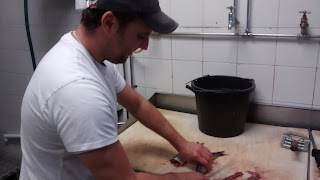Herring Tales: How the Silver Darlings Shaped Human Taste and History
By Donald Murray. Bloomsbury Publishing; 272 pages; $26 and £16.99.
THE herring is hardly the grandest of fish, but as a cheap source of protein it is hard to beat, and herring-fishing was a way of life for many communities around the North Atlantic from the Middle Ages up to the 20th century. Trade in the fish made merchants wealthy. In Scotland herring are known as “the silver darlings”; in Norway they are called, even more lovingly, “the gold of the sea”.
A new account of the herring industry by Donald Murray, a journalist and poet, has almost as many facets as his slippery subjects have scales. His tale offers fillets of history, culture and zoology, with an emphasis on the eclectic—not to say wilfully eccentric. Yet his approach faithfully reflects our relationship with Clupea harengus, which has never been straightforward.
Part of the herring’s attraction for mankind lies in its sociability. It forms vast shoals, a trail of silver below the ocean’s surface that is irresistible for fishermen. But this is a notoriously fickle fish. Until the 15th century herring thronged the Baltic, enriching many of the cities of the Hanseatic League. Then they vanished from the area, never to return in such huge numbers, leaving fishermen bereft and baffled in their wake. The fish later tarried for long enough around Scotland to become an important part of the country’s income. At the industry’s high point there, in the period immediately before the first world war, 2m-3m barrels were caught each year.
Soon after, overfishing started to take its toll on herring populations. Factory ships were built by the Dutch as early as the 15th century, to salt the fish while still at sea, but it was in the late 20th century that boats became big and efficient enough to run down the stocks. Enormous, dilapidated vessels from Iron Curtain countries hunted down the remaining fish, thus speeding the industry’s decline (though it has since made a partial recovery). Life aboard these gigantic rust-buckets was strange; Mr Murray recounts that no fewer than 40 crew members on one Romanian vessel were secret policemen.
The fish’s culinary charms extend far beyond kippers and rollmops. Jewish communities have been notably inventive with recipes, reaching a creative peak with the likes of chopped herring topped with crushed chocolate biscuits. Even more of an acquired taste is the foul-smelling fermented herring, called surstromming, which Swedes have relished since at least the 16th century.
Nowadays the herring’s role is as much cultural as economic. Mr Murray tours former fishing villages which today have become homes to artists, writers and musicians who use their work to celebrating the silver darlings. The fish remains a focus for national and regional pride, with lively annual festivals in France, the Netherlands and Norway.
The herring also provides classic arguments for conservation, not least thanks to its many uses beyond direct nutrition. The guts make fine fertiliser, and herring oil was used for lighting until the mid-19th century. As evidence accumulates about the dangers of using fossil fuels, old ways of this sort may become fashionable again. In the meantime, Mr Murray is a gregarious and engaging raconteur as he flips between the diverse aspects of this versatile little creature.









